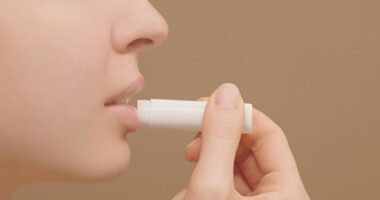Share this @internewscast.com
At just 12 years old, Hallie Jenkins was eager to flaunt her newly pierced ears, having finally convinced her mother, Sarah, to allow the procedure.
However, what began as a simple fashion choice turned into a nightmare. Hallie’s piercings resulted in unsightly growths on her ears, making her self-conscious and reluctant to wear her hair up, fearing ridicule from peers. Ultimately, she required surgical intervention to address the issue.
Originally from Pontypridd, South Wales, Hallie, now 15, had her ears pierced for the first time at seven without any problems. Trouble began when she opted to have her lobes pierced again at the age of ten. Within a year, large growths began to develop, resembling tiny bunches of grapes. The situation worsened when she pierced the upper part of her right ear at 12, leading to another significant lump of scar tissue encircling the piercing.
As the growths expanded, eventually engulfing the earring, Sarah, 36, became concerned and took Hallie to the emergency room. There, doctors successfully removed the earring but diagnosed Hallie with severe keloid scars.
Keloids are excessive scar tissue growths that progressively enlarge. The NHS typically classifies them as a cosmetic issue, meaning treatment is usually not provided unless they pose a health risk. Consequently, many patients face expensive surgeries, often costing thousands.
Sarah laments that none of the retail outlets where Hallie had her ears pierced ever warned them about the potential for such scarring.
And when she later raised it with them, they dismissed her concerns and said the growths were nothing to worry about.

Hallie Jenkins, 15, has now had the scar tissue removed
Sarah is far from alone. Data due to be presented at the annual scientific meeting of the British Association of Plastic Reconstructive and Aesthetic Surgeons in Belfast next month will show that few high street piercing shops warn of the risks of keloid scars. This is despite the fact that, according to studies, around one in 40 ear piercings triggers a keloid scar.
The situation has been described as ‘horrifying’ because, with prompt treatment, the scars can be prevented or reversed without the need for surgery. Sarah says: ‘I am horrified that parents are taking children to have their ears pierced and are not being told of the risks. If we had been, we would have known what steps to take to minimise the growths.’
Bristol-based plastic surgeon James Henderson, who co-authored the study with surgical trainee and registrar Marina Ibrahim, says that their results were ‘shocking’.
‘Why the industry isn’t better regulated is beyond me,’ he adds. ‘The fact that you can be a piercer after just a few hours of training is horrifying. They should be robustly trained and in a position to give customers information on all the risks of piercing.
‘They should be showing them images of scars so they can more easily recognise one forming and take immediate action.’
All ear piercing shops in England are regulated by local authorities, which oversee hygiene standards. But there are no legal requirements for professional competence for piercing.
Scarring is a part of tissue repair. When a wound heals, inflammatory reactions trigger the formation of blood vessels and the production of skin cells and fibroblasts, which make collagen, the protein that gives skin its strength and elasticity. These close the wound and shield it from infection.
But when too many fibroblasts are produced, the layers of collagen are not laid down in the neat pattern that makes up the rest of the skin, so they stand out – resulting in keloid scars.

Hallie’s ketoids pictured before surgery, left, and afterwards
‘People need to be made aware of the risks of keloid scarring following piercing, and the onus should be on the piercer to provide this,’ says Mr Henderson. ‘If this was a treatment administered by a doctor, there would be a long list of possible risks given out – but in this case nobody even mentions it.’
Crucially, if caught quickly, keloid scars can be avoided.
Treatment can include steroid injections to dampen down the inflammation and reduce the risk of permanent damage, while other treatments include cryoptherapy, where the growths are frozen with liquid nitrogen.
If these options fail, then Mr Henderson says it costs around £1,400 per ear to surgically treat keloid scars privately, which usually takes less than an hour and is done under local anaesthetic.
In August, Hallie had her growths removed by Mr Henderson. It’s had such a positive effect that she had the confidence to enter the Miss Teen Great Britain beauty pageant – and has made it through to the finals next year.
‘She is so much happier now,’ says Sarah. ‘She can wear her hair up again without feeling so terribly self-conscious’.

















